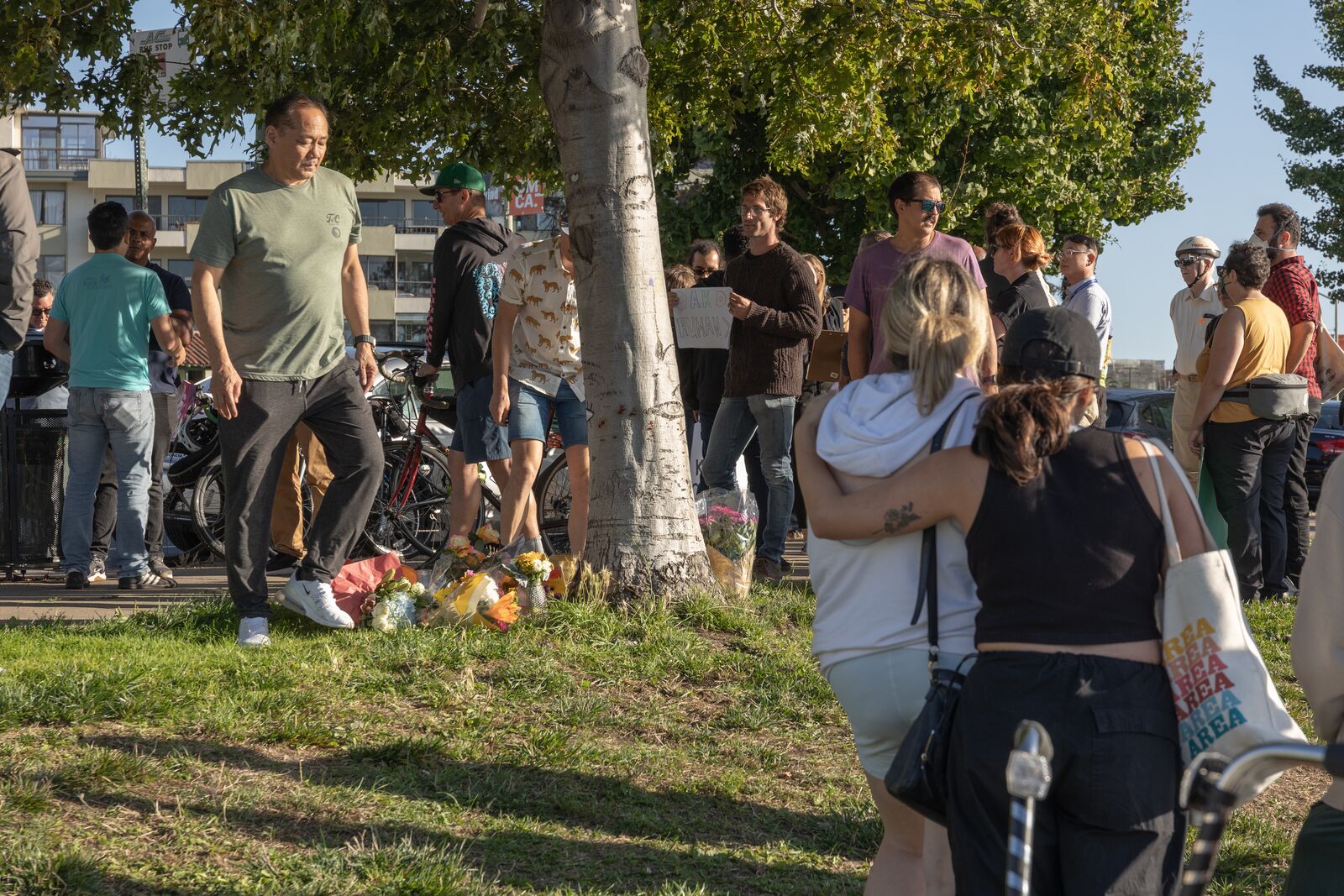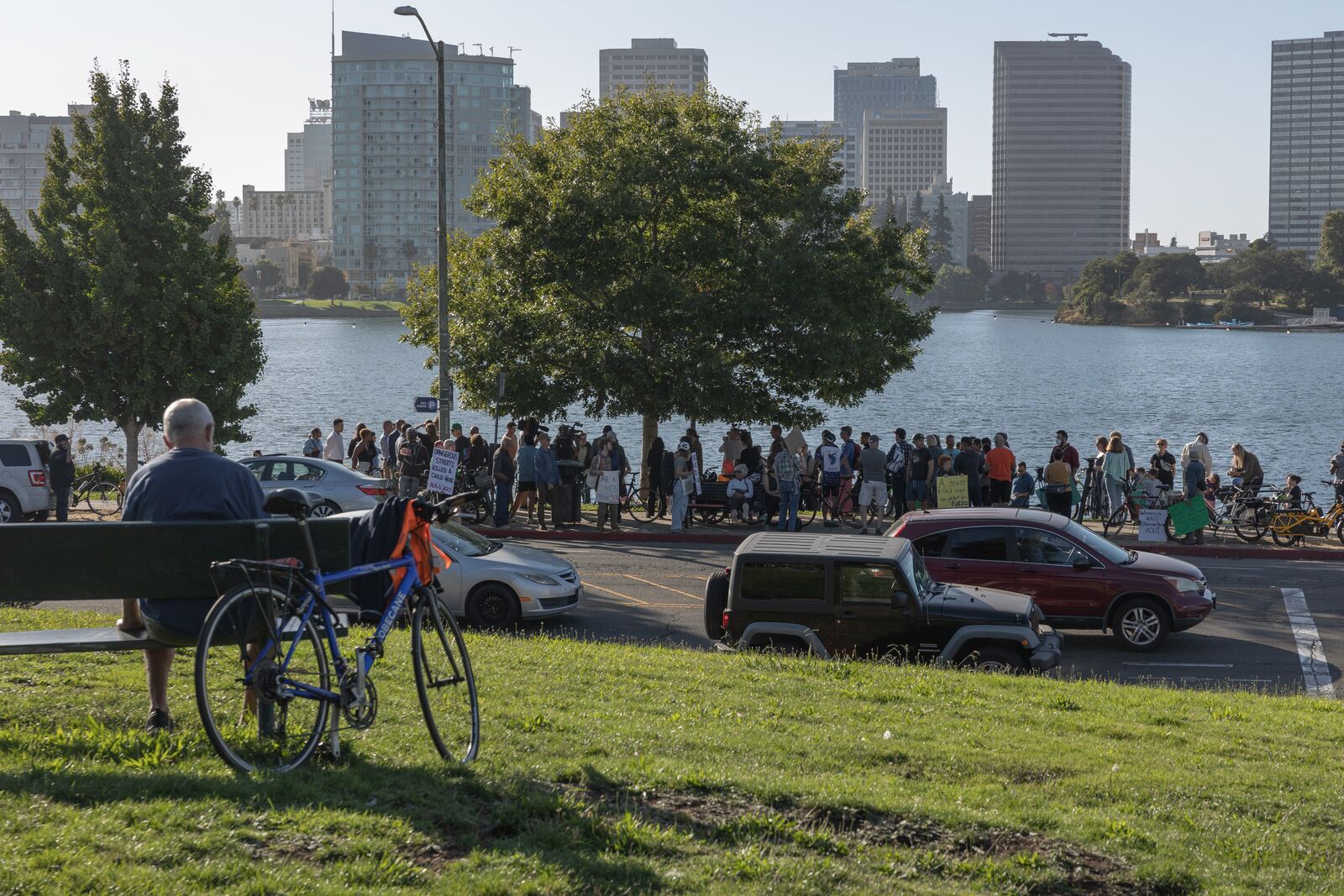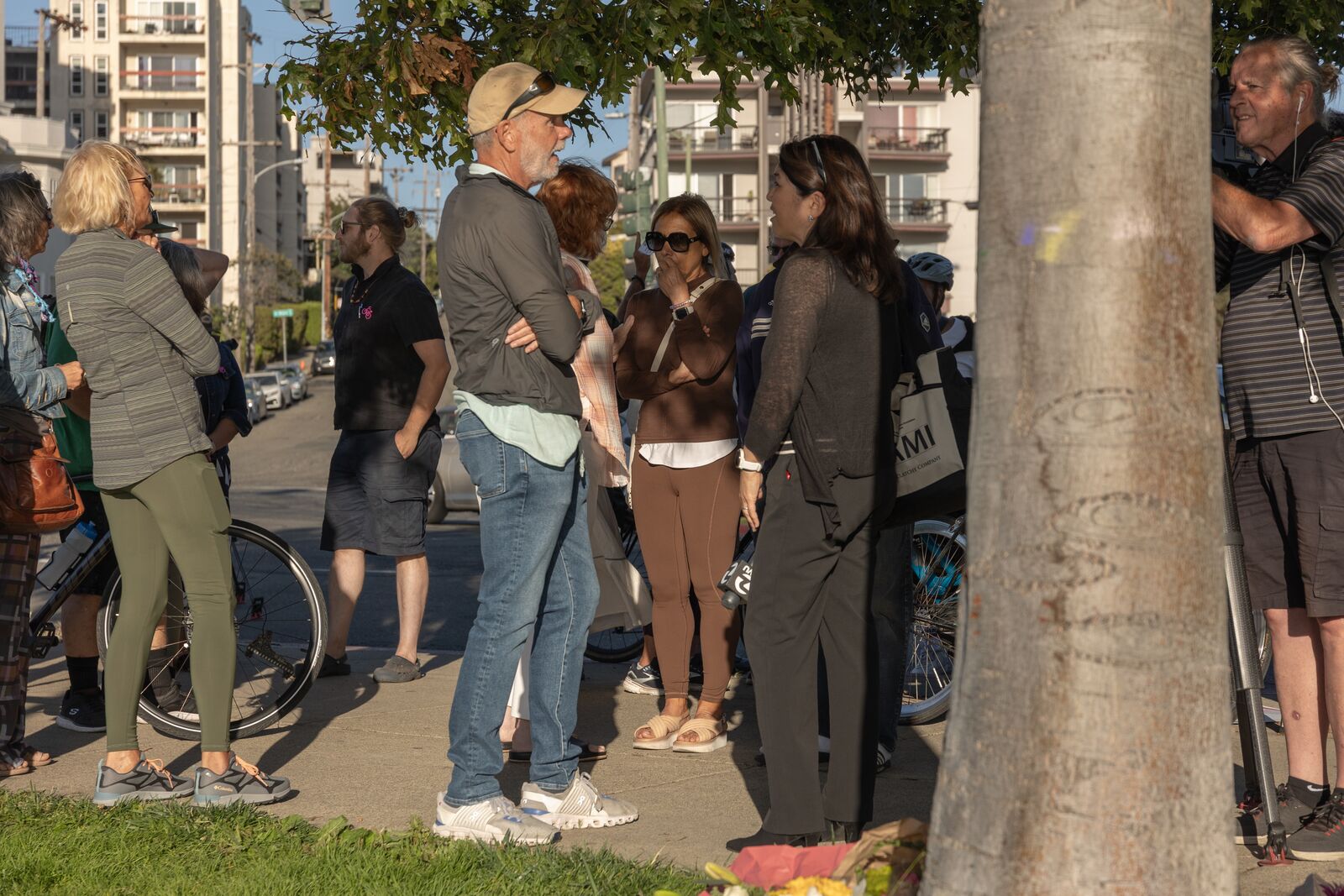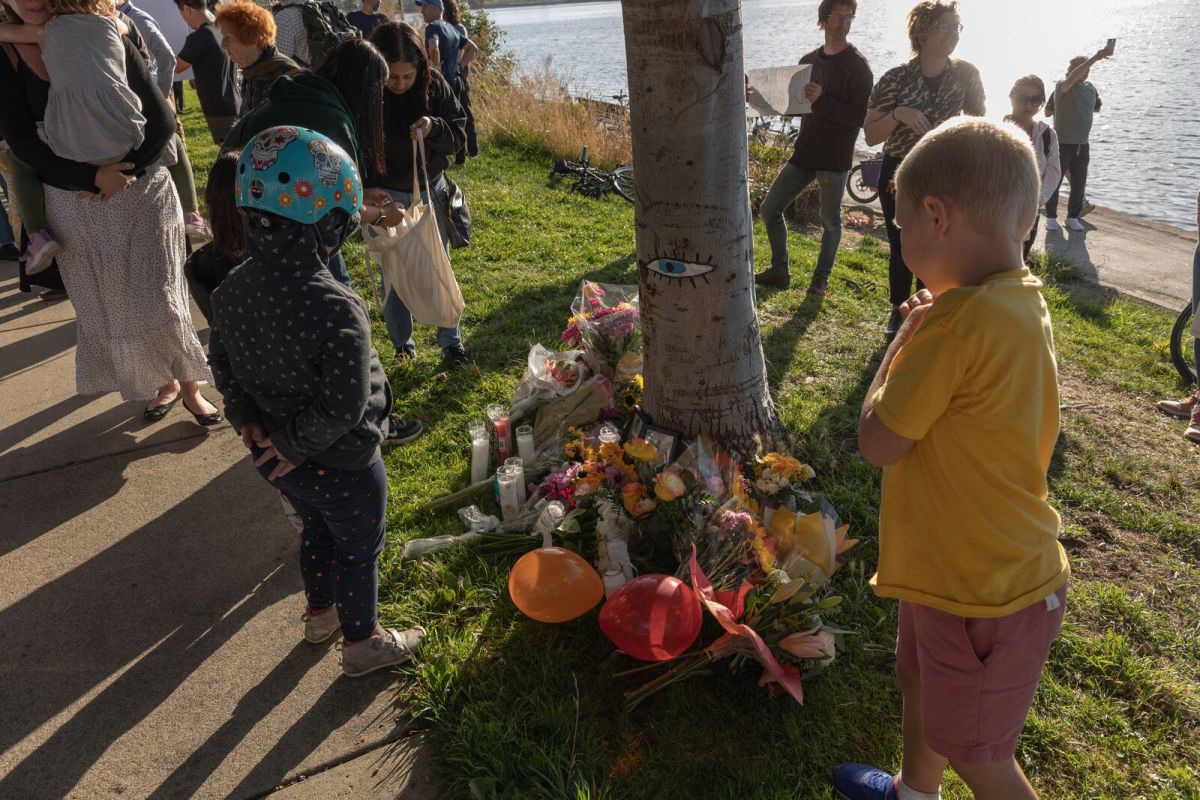Four weeks after losing his grandchild Maia Correia to a head injury from a tragic road collision, Richard McCracken said he still can’t believe she is gone.
“I can’t understand my granddaughter not being here, walking with me today, riding with me here,” McCracken said, standing on the grassy edge of Lake Merritt as he looked down at a small, wood-framed picture of Maia resting against a tree amidst flowers and balloons.
“I thought I had a great life. I have a great family. And then this accident happened, and whatever world I had was messed up. I can’t describe what it feels like. It’s the worst thing that’s ever happened to us,” said McCracken.
On Wednesday evening, more than 40 people gathered at Lakeshore Avenue and Hanover Avenue, where Maia and her father Jadd Correia were injured on Aug. 6. Maia was riding on the back of her father’s bicycle when a driver opened his parked car’s door as they passed him in the southbound bike lane. They struck the car door and fell into the street where Maia hit her head. Maia died from a brain hemorrhage at Oakland’s Children’s Hospital a few days later.
The vigil celebrated the four-year-old’s vibrant personality and called for improved road conditions around the lake, particularly for protected bike lanes that could have prevented the collision. Currently, the bike lane on Lakeshore Avenue is “buffered,” or painted, and is in a small, narrow space between parked cars and the vehicle lane.
“I look at all these kids and parents [that are here, and] I just want ’em to hold their children, hug their grandchildren and not have this occur in their life,” McCracken said.

Many of the people who were walking by and stopped near the memorial weren’t aware of the deadly crash. They responded in a solemn silence or voiced concerns about their safety while walking and biking around the lake.
Members of the advocacy groups Bike East Bay and Traffic Violence Rapid Response organized the vigil with the permission of the Correia and McCracken families.
Bike East Bay has advocated for bike safety in the Bay Area for more than two decades, while Traffic Violence Rapid Response began organizing about 16 months ago after Jonathan Waters, a well-known sommelier, was killed at Shattuck Avenue and 55th Street while riding a bike.
Recently, the two groups and Walk Oakland Bike Oakland have called for improved protection around Lake Merritt because it is one of the city’s most used recreational areas. According to UC Berkeley’s Transportation Injury Mapping System, 98 people on Lakeshore Avenue suffered injuries between El Embarcadero and Lake Merritt Boulevard from 2011 to 2022.
George Spies, one of the members of Rapid Response, told us it was essential to consider that the collision that killed Maia resulted from a design feature and not an individual’s reckless decision.
“There’s no assigning guilt to a kid, and there’s no splitting the difference in this issue,” Spies said.

Fred Kelley, Director of Oakland Department of Transportation, attended the rally to show support for the family and express to residents that road safety is a priority to the city.
OakDOT announced its response to the tragedy yesterday also.
In a series of messages on Twitter, the department said that after evaluating the collision and speaking to the police, they have decided to add signs reminding parked drivers to look out for cyclists before opening car doors. They will also partner with local organizations to promote a series of biking and driving education videos in English and Spanish, which explain how to avoid risky roadway decisions such as driving in bike lanes.
OakDOT said it will also conduct an additional street design study to improve the corridor’s safety around the lake.
Some people at the vigil on Wednesday told The Oaklandside they appreciated the planned response from OakDOT. Still, others said the need for a protected lane was obvious, that it shouldn’t require additional studies, and that any prolonged wait for changes will likely lead to further unnecessary deaths.
Natalie Mall, a Rapid Response volunteer, told us Lakeshore Avenue was, like many other Oakland streets, “deadly by design” and that any additional study would only reinforce what tragedies like Maia’s death have already shown: there’s not enough protection around the lake for cyclists.
Rapid Response’s Spies said OakDOT’s plan “won’t make a dent” in the issue. “It is ludicrous,” he told us yesterday. “I mean, I get it. They can’t run out here tomorrow and build a full [concrete] protected bike lane. But they could make a k-rail-protected bike lane, for example.”
Building developers commonly use K-rails for construction projects to create safe impromptu pedestrian or bike paths beside city roads.

The office of Council President Nikki Fortunato Bas, whose district is next to where Maia and her father were hit, released a statement detailing her commitment to improving road safety.
“As a mother, my heart grieves with the family who lost their child and now lives with this unimaginable void. As a cyclist, I ride down Lakeshore and know first-hand how narrow the space is between your body and a car door,” Bas wrote. “Implementing these improvements is more urgent than ever after bearing the 15th traffic death in Oakland this year.”
At the vigil, The Oaklandside spoke to some of the city’s road engineers responsible for making those changes. None wanted to be identified by name because they didn’t have permission from the city to speak to the press, but they provided us with a sense of how they felt after hearing about Maia’s death and how the tragedy relates to the current state of Oakland roads and their work trying to improve them.
One engineer told us they are heartbroken by Maia’s story. They became a road designer to prevent accidents and they feel the city is slowly working towards making roads safer through new infrastructure. However, a lack of resources, including an overworked city staff, often forces them to postpone projects.
A second engineer told us it was sobering to realize that buffered bike lanes, his profession’s formerly “gold standard” project to make roads safer for cyclists, were no longer enough to prevent serious injuries. He said protected lanes are probably needed based on the conditions in Oakland, and how many people speed and drive recklessly.

A friend of the Correia family at the rally, Justine Waters, said she used to bike to the Oakland waterfront to take the ferry to her job in San Francisco but that Oakland’s poor road conditions have forced her off her bike.
“I feel a lot better when I [ride] on protected lanes,” she said. “When they didn’t have those lanes on Telegraph Avenue, I definitely tried to have my head on a swivel as much as possible,” she said.
Tony Lufrano said he was feeling the pain and grief of his friends. He has tried to understand the level of pain they’re going through.
“I know that this stuff happens all the time, but it’s hitting especially close to home,” he said. “I’m just showing up in any way I possibly can.”
Waters said she’s trying to help Maia’s family go through the ebbs and flows of grief. “There will be days that are better than others,” she said.

Maia’s grandmother, Hydeh Ghaffari, also attended the vigil. She told us she has been unable to feel normal since Maia’s passing.
“When people ask me how I am, I can’t answer,” she said, visibly shaking. The only thing that has helped her get up every morning, she said, is the desire to change road conditions so her granddaughter’s death can lead to a positive change.
Richard McCracken told us the family now realizes they are part of a larger, unfortunate group of people who have to pressure the city into developing an urgent response against unsafe roads.
“When are you gonna do it? When are you gonna fix things?” he asked Oakland officials, shaking his head with tears in his eyes. “How many children do you wanna see that are out on a Sunday afternoon with their father and then see that child in the ICU at the Children’s Hospital suffering brain-stem damage from her head hitting the ground? When will we have the ability to change it? It would mean a lot to me and other families that have lost somebody this way, to do something to show they care.”

